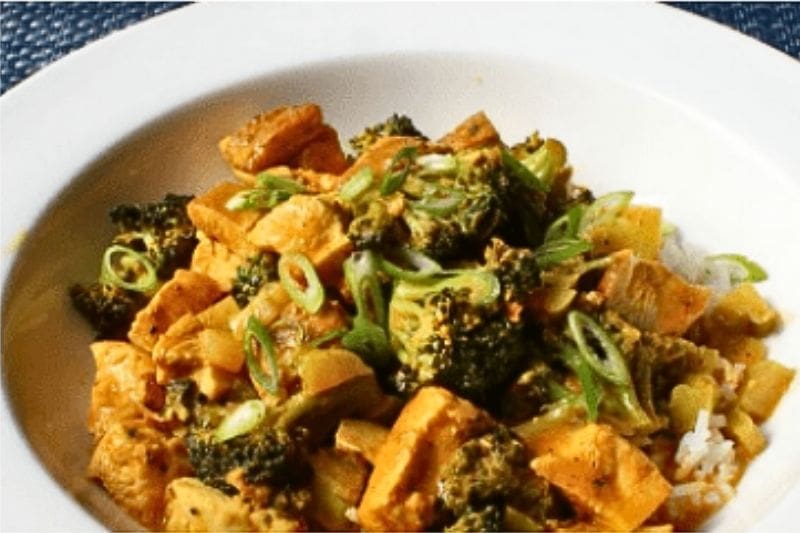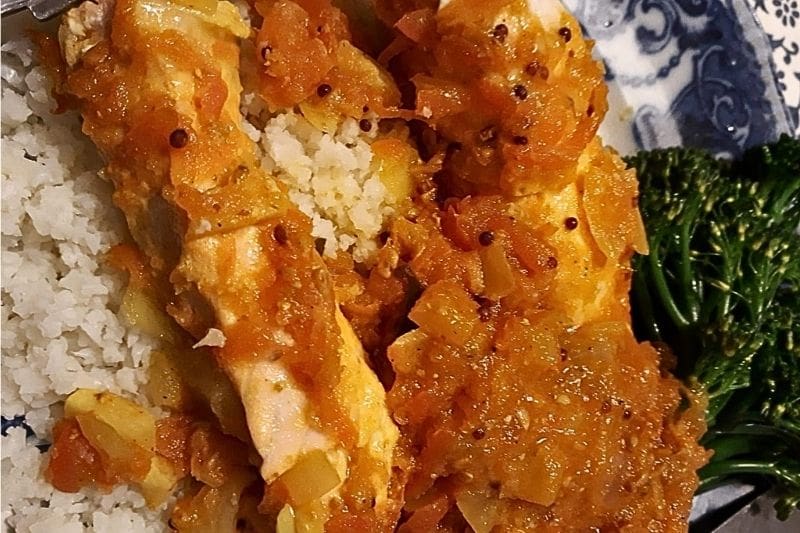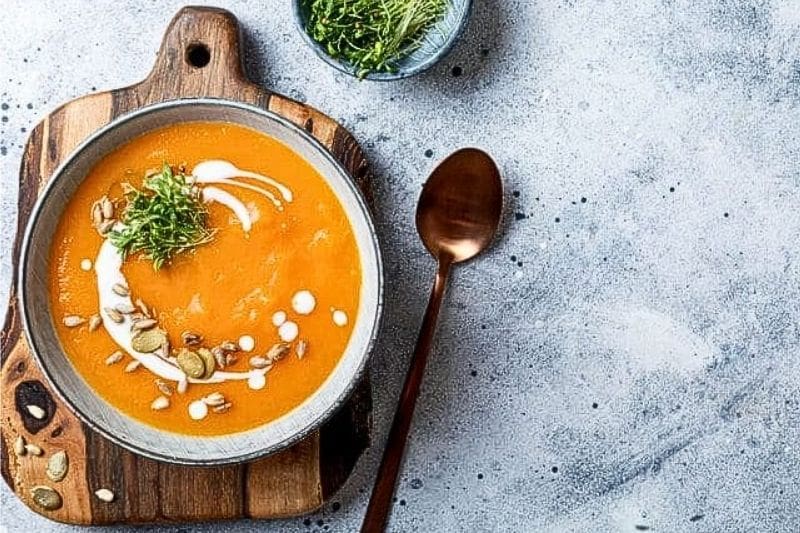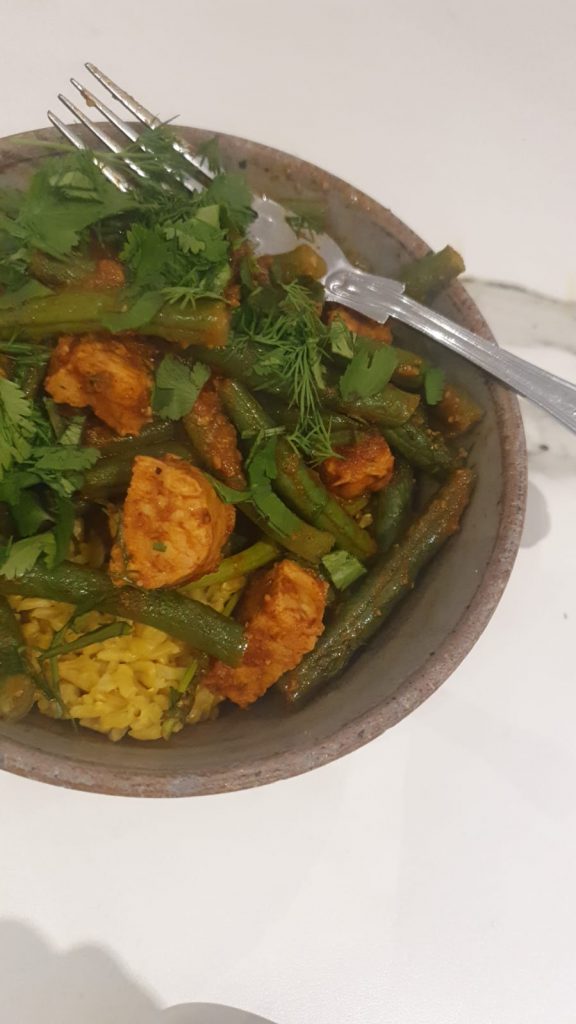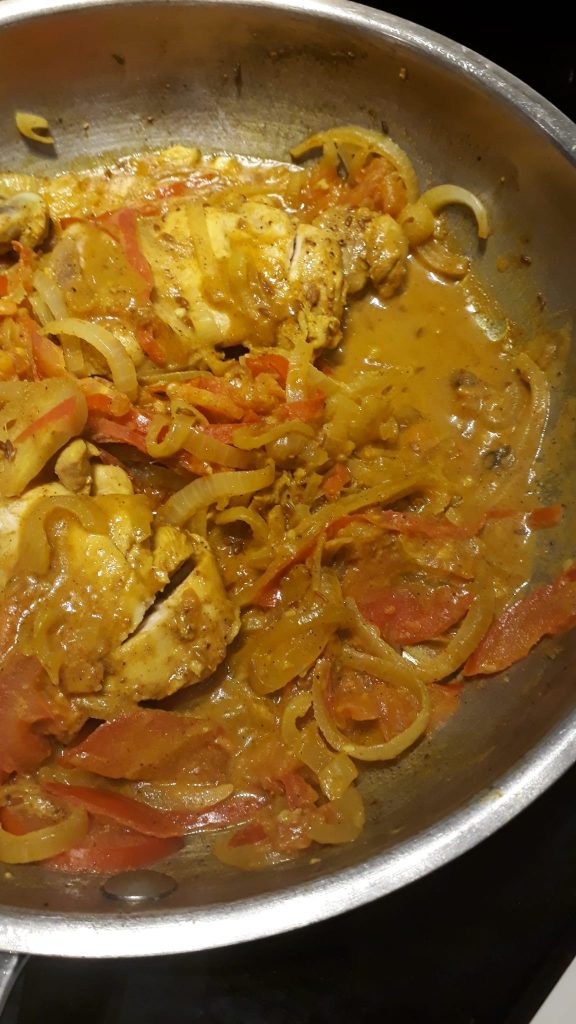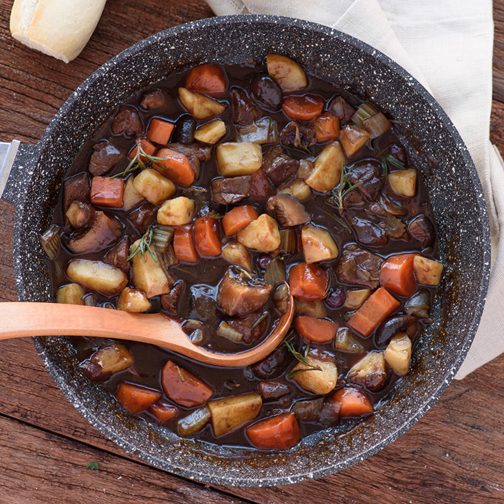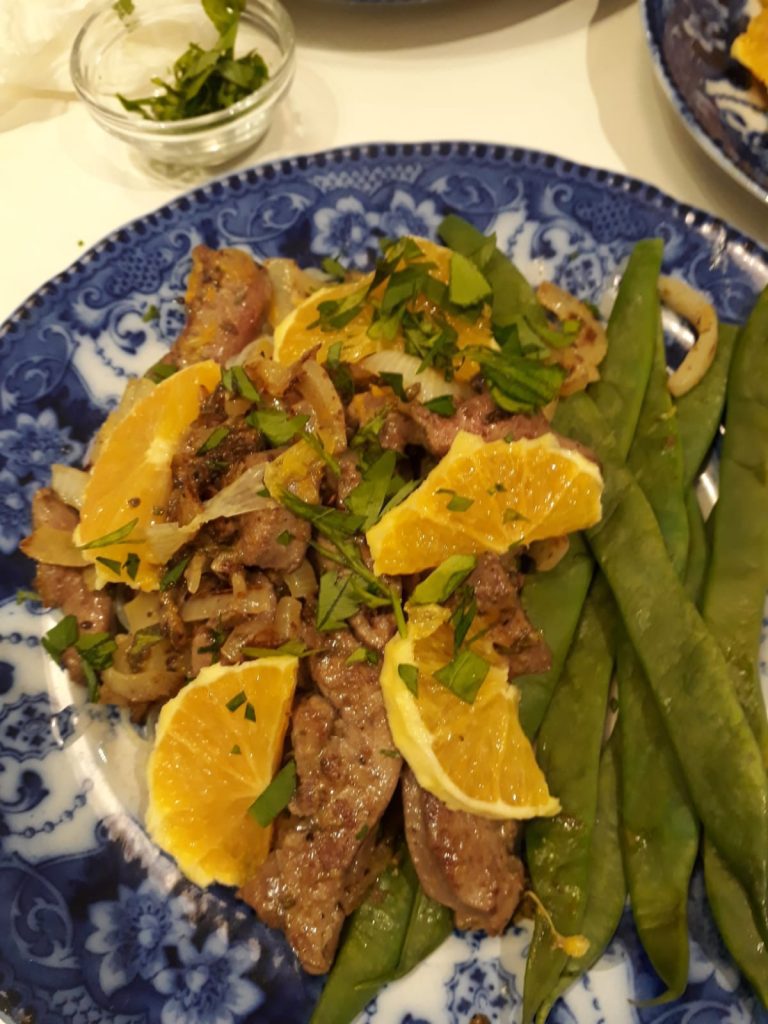
Nov 21, 2024 | Anna's Best Recipes, Main courses
Leftover chicken/turkey and broccoli curry
1 large onion peeled and sliced finely
250 g leftover cooked chicken off the bone, shredded
1 can (400g) chopped tomatoes
2 large cloves garlic, crushed
1 heaped tsp (teaspoon) each of ground coriander + cumin
2 heaped tsp garam masala
Optional chilli powder 1/2 level teaspoon for heat
If you don’t have those spices, 4 tsp gluten-free curry powder will do
1 level dessertspoon virgin coconut oil or ghee
150-200g tenderstem broccoli, cut in 4cm lengths
150g (1 mug to brim) frozen peas
100ml chicken stock or water
100ml (nearly ½ a big can) full fat coconut milk
Salt and Pepper to taste
Optional: fresh coriander leaves to garnish
1. Steam-fry onions: put them with the oil and 1 dsp water into a heavy bottomed saucepan, cover with lid or plate. Cook on medium heat till soft and translucent (around 12 mins). You don’t want them to brown. Browned food is damaging to our health.
2. Add the crushed garlic, spices and stir around for a minute.
3. Add tomatoes, coconut milk and chicken stock/water to the pan and simmer for 10 minutes, stirring regularly till the mixture is a bit thickened. Season to taste.
4. Add chicken, broccoli, put the lid on and cook for a further 5 minutes until the broccoli has changed colour and the chicken is heated through. While you’re waiting for this, pour some hot water over your frozen peas in a strainer to thaw them quickly. Add to the pot a couple of minutes before the end so they’re still an appetizing bright green when you come to eat.
5. Garnish with fresh coriander leaves if you have them.
Serve with:
Low carb (lower carbohydrate = lower sugars): 1 cup cauliflower rice per person
Medium carb (if you do not want to drop weight) brown basmati rice (measure 1/4 mug per person dry weight and cook in twice its volume of boiling water from the kettle).
Variations and swaps:
Instead of the coconut milk use 30g creamed coconut from a block you can buy in Asian shops. Chop it up before adding to the pan with the tomatoes so it doesn’t take ages to melt!. This is very economical cos you just use what you need and keep the rest in the fridge for another time.
Why this is good for you
We’ve all gone a bit fat phobic, culturally. But it is high carbohydrate diets (lots of grains like wheat rice or pasta, potatoes and sugar or fruit juices) that pile on the weight. And cause inflammation in your arteries i.e. heart disease. Refined or heated nut/seed oils are another big driver. So sticking with healthier oils like ghee, coconut milk and olive oil and limiting your carb intake keeps you healthier. Herbs and spices and powerhouses for your health. They are natural anti-inflammatories and alter your gut micro-biome (the micro organisms in our gut we need for health). Alter it in favour of the good guys that regulate weight, blood pressure and every single metric of health, including preventing digestive disorders and diabetes.

Jan 27, 2024 | Anna's Best Recipes, Main courses
This salmon cooked in sauce is DELICIOUS. If you want make the cook-in sauce in advance to save faff if you’re having people around. The original recipe by Madhur Jaffrey involves marinating the salmon but I skip that and it still turns out fab. I love this served with a generous amount of broccoli/tenderstem. If you dont want to lose weight add some more carbs by measuring ¼ cup brown basmati rice per person and cooking that with a generous pinch of turmeric (added health benefits plus lovely colour!).
Tip: Buy your individual spices in Asian shops. If you have a coffee grinder try grinding some of your own spices – you’ll really notice the flavour explosion. Always keep ground spices airtight in a dark place to preserve aroma.
For 2
300g skinless salmon fillets/2 x 150g skinless darnes
For the sauce:
1 tsp whole mustard seeds
1 level tsp mustard powder
1 dsp ground coriander
½ tsp ground cumin
1/2 tsp ground turmeric
½ tsp tsp curry powder
½ tsp cayenne pepper
150g tomatoes, coarsely grated or chopped small, with their juice
1 tbs extra virgin olive or coconut oil
½ tsp whole fennel seeds
10 fresh curry leaves or 6 bay leaves or fresh coriander
To serve:
2 cups broccoli florets/tenderstem broccoli per person
Low carb: cauliflower rice
Medium carb: brown basmati rice (measure 1/4 cup per person before cooking)
If you’re using brown rice with this, first of all:
Put on the kettle, rinse rice in a sieve under cold running water (to remove toxic arsenic which accumulates on the surface of the grains). Cook rice in twice its volume of boiling water e.g. For 2 people ½ cup rice 1 cup boiling water. Add generous pinch turmeric, cover with a lid, simmer till done.
1. Cut salmon into matchbox-sized pieces or (if you don’t mind waiting longer for it to cook) leave 2 darnes whole.
2. Now make the sauce. Put the ground mustard, ground coriander, cumin, turmeric, curry powder, cayenne, tomatoes, curry leaves or bay leaves, generous pinch salt and 100ml water in a bowl and mix well.
3. Heat oil in a wide, shallow pan (a deep frying pan is ideal) over a medium-high heat.
4. Add mustard seeds. As soon as they begin to pop add fennel seeds.
5. Pour in the spice-tomato mixture and 80-100ml more water, bring to a simmer and cook gently for 10 minutes. At this point sauce can be cooled and refrigerated until you are ready to cook the fish. It will keep a couple of days.
6. To cook the fish, reheat sauce in wide shallow pan and lay the fish in it spooning some of the sauce over the fish to coat it all over.
7. Cover pan with a lid or plate and cook for 5-10 minutes until the salmon is cooked through. Around 5 mins for matchbox sized pieces, around 10 for whole darnes.
Why this is good for you:
Cooking with herbs and spices liberates a powerhouse of antioxidant anti-inflammatory processes in your body. Herbs are antioxidant. They also make your body produce more of its own antioxidants. They also (provided they’re properly kept airtight in a dark place) make your gut a VERY unfriendly place for bad bugs. This allows friendly bacteria more space to grow, promoting more vigorous physical and mental function. Whats not to like. And of course we all know by now that omega 3 fats from oily fish are anti-inflammatory, promote good mental and heart health and even make the cancer cells we all produce more easily destroyed by your immune system.

Sep 28, 2023 | Anna's Best Recipes, Main courses, Sides, starters, soups & snacks
Now Autumn’s here and with it some crazy storms I’ve rediscovered this high protein immune-supporting soup that’s a bowl full of sunshine. To make it into a complete meal add a cupful of cooked greens per person at the end (a bag of baby spinach would do). If you want to gain weight, add some extra carbs such as wholemeal gluten-free bread or leftover cooked rice (reheat well in the soup). If you eat gluten) some 100% rye or wholemeal sourdough. This soup freezes well too.
For 4
Note: You can save yourself effort chop all veg and spices only roughly if you’re going to blend the soup later on.
1 very large onion or 2 medium chopped onions
2 large sticks celery, sliced
2 large carrots (about 300g), sliced
2 heaped tbs (tablespoons) finely grated fresh ginger
1-2 rounded tbs ghee or virgin coconut oil (if you have an inflamed gut, ghee is best).
3 cloves garlic, crushed
Heaped teaspoon turmeric powder
Heaped teaspoon coriander powder
1/2 level tsp ground cardamom powder if you have it
500ml carton of passata (sieved tomatoes) or a 400g can chopped tomatoes
750ml filtered water or leftover vegetable cooking water (e.g. from steaming veg)
250g (mug and a quarter) dried red lentils
1 heaped tsp health store additive-free vegetable stock powder (for the SC Diet use Dr Coys Organic Vegetable Bouillon)
Freshly ground black pepper
1. Heat a large heavy-bottomed saucepan with lid on a medium heat for a minute. Add ghee/oil, onion, celery, carrots, ginger and a small splash of water, cover with a lid and sweat for 10 minutes.
2. Add garlic, turmeric and cardamom if you have it, stir for a minute before adding passata/tinned tomatoes and water.
3.Give everything a stir then add the lentils so they sit on top (otherwise during cooking they stick to the bottom). If the lentils are not entirely submerged in liquid, add a bit more water or stock.
4. Boil for 15-20 mins for 20 mins/until lentils and veg are soft. Only stir the lentils gently at the very top if they are stuck together, otherwise leave them alone.
5. Mix the veg stock powder into a little water and add to the soup AFTER the the lentils are soft (otherwise salt makes the lentils touch).
4. If you want a smooth soup now give it a whizz with a stick blender.
5 reasons this is good for you:
Lentils and onions contain prebiotic fibre. This feeds friendly bacteria you need for healthy digestive system and immunity.
Turmeric, ginger, garlic, coconut oil, cardamom and coriander reduce numbers of disease-causing bacteria/viruses in your gut.
Processed cooked tomatoes are the richest source of antioxidant lycopene to help ALL of you
Ghee contains butyric acid, a metabolite produced by friendly bowel bacteria to keep your gut and immune system tip-top.
Lentils are a rich and easy-to-digest source of protein which is essential for antibody production to protect against infection.

Mar 31, 2022 | Anna's Best Recipes, Main courses, Sides, starters, soups & snacks
Just invented this last week from what we had in the fridge. It’s LOVELY with its blend of salty, smokey and fresh flavours. Lovely with a fresh mixed salad. Make sure to buy actual feta which is made from ewe (sheep) or goat milk. Do try to avoid the nasty pitted olives in black water available in supermarkets – they have almost no flavour and are only black because of black food dye. If you want to save, get your black olives in middle Eastern shops where they’re great value.
I don’t add the mint until just before serving as it goes limp quickly.
1 packet (around 200g) feta, cut in bite sized cubes as small as you like
1 large aubergine
Heaped teaspoon (or more) ground coriander
3 dsp extra virgin olive oil (EVOO)
1 dsp lemon juice or apple cider vinegar
Freshly ground black pepper
Handful un-pitted olives (ideally wrinkly dry black ones or kalamata)
Generous handful washed mint leaves
- Turn on grill to high.
- Slice an aubergine in 1cm (or a bit thinner) slices (disks or lengthways, whatever you prefer).
- Put aubergine slices on grill, brush with extra virgin olive oil (EVOO) and sprinkle with a little ground coriander. Grill till golden while you assemble the other ingredients. Then turn and repeat the process. Remove from heat and allow to cool slightly. Cut into bite size pieces or strips (I use a scissors to do this quickly).
- Into a large serving bowl put aubergine, olives, feta, EVOO, lemon juice/vinegar and a few generous grinds of black pepper and gently mix everything.
- Just before serving chop the mint. Sprinkle it over the top or mix it in.
Serve with:
Low carb: A big mixed salad dressed with my favourite dressing https://www.annacollins.ie/mediterranean-salad-dressing/
Medium carb: Salad + something starchy like wholemeal gluten-free bread or (for gluten eaters) a nice wholemeal rye sourdough.
Why this is good for you (provided you’re not dairy-sensitive!):
Goats and sheep’s cheese are high in protein and FAR more easy for humans to digest than cow. Modern (Jersey) cow’s milk contains A1 beta casein which is hard to digest. Goat and sheep milk contains 80% less of this problematic casein. Olives are a fermented food and contain beneficial bacteria to help your gut. Mint, like most herbs/spices, helps make your gut a hostile place for disease-causing bacteria and is also rich in polyphenols. Polyphenols are natural plant compounds shown to be anti-inflammatory, anti-oxidant and hugely supportive of your health – gut, brain, skin and more. What’s not to like?

Jan 30, 2022 | Anna's Best Recipes, Main courses
This is my current favourite way to use tofu or tempeh. I adapted it from Ottolenghi’s more complex recipe. My husband is a tofu-hater so when he disappears for a few days I always cook this. Keep in mind that unfermented soya products contain digestion-blocking proteins that damage your gut. So DO make sure to buy the fermented forms for this dish: tempeh or fermented tofu (it will say on the pack).
If you don’t have a small-bowl food processor, chop the chili finely, crush the garlic and use a pestle and mortar to bash the caraway seeds about as much as you can before mixing with the other spices and oil.
For 2
This is gorgeous served with cauliflower/broccoli “rice”, konjac noodles or brown basmati rice.
350g trimmed French (or use runner beans cut in 6cm bits)
Salt and black pepper
200g non-GMO tempeh or fermented tofu, cut into bite size cubes
A few sprigs of dill (small handful), destalked and roughly chopped
Small handful fresh coriander, destalked and roughly chopped
For the sauce:
4 garlic cloves, peeled and crushed
1 green or red chili, deseeded (optional)
2 slightly rounded tsp sweet paprika
1 tbs caraway seeds
1.5 tsp ground cumin
½ level tsp ground Ceylon cinnamon
2 tbs + a little extra avocado oil or extra virgin olive oil
3 tbs tomato puree
250ml water or leftover vegetable-steaming water (full of nutrients!)
Optional: 1 heaped tsp honey or non-toxic sweetener e.g. Dr Coy’s Stevia Erylite or xylitol (from good health stores)
2 limes
Black pepper
Himalayan or sea salt
- For the sauce put the garlic, spices, chili and 2 tbs oil in the small bowl of the food processer and blitz to a thick paste. You might need a touch more oil to bring it together.
- Heat a pan on a medium heat and add a teaspoon more of avocado/olive oil and stir fry the garlic-spice mix for 30 seconds.
- Then add the tomato puree, 250ml water and bring to the boil.
- Stir in the honey or non-toxic sweetener, lime juice, generous pinch (1/4 a level tsp) salt and a few good grinds of black pepper.
- Add the tempeh, turn down the heat, cover and simmer while you prep the green veg.
- Steam the French/runner beans for around 2-3 minutes until the colour changes very slightly and they are softened but still have a bit of crunch.
- Finally, just before serving, stir the herbs into the tofu and sauce, pile on top of your rice and enjoy.
Serve with:
Low carb: Cauliflower or broccoli rice https://www.annacollins.ie/cauliflower-rice/ or konjac noodles from Asian stores.
Medium carb: brown basmati rice cooked with a generous pinch of turmeric
Why this is good for you:
Spices are a powerhouse of antioxidants that help rebalance your gut bacteria in favour of the good guys. The good guys helps digest your food, repair and maintain your gut lining every minute of every day, and reduce inflammation in you. This has massive implications for your immune system, your gut health and even your mood. Yes, anxiety/depression states always involve brain inflammation. Type the name of just one spice into medline (the scientific journal resource) and you’ll find hundreds of peer-reviewed scientific studies.

Jan 23, 2022 | Anna's Best Recipes, Main courses
This is another fantastic and quick recipe by Chetna Makan. Again I’ve taken out the toxic refined cooking oil and swapped in the better-for-you coconut oil. I’ve also added onions to bulk it up and add even more goodness for your long-term health. I’ve increased the quantity of sauce too, as I love sauce.
For 2
200ml natural full fat yoghurt (for SC diet use home made full fat kefir or 24-hour SCD yoghurt)
1/2 level tsp Himalayan/sea salt
1 tsp garam masala
½ tsp ground turmeric
½ level tsp chilli or (the milder) cayenne
2 large garlic cloves, peeled and crushed
300g boneless, skinless chicken thighs, cut into 3cm pieces
1 onion, finely sliced or chopped
1 tbs virgin coconut oil
1 tsp cumin seeds
2 tomatoes, thinly sliced
20g fresh coriander leaves, roughly chopped (a handful of whole coriander will give you enough).
1.Mix the yoghurt/kefir, salt, spices and garlic in a bowl. Add the chicken pieces, turn until well coated, then leave to marinate while you prepare the curry base. If you are planning ahead you can marinate these in the fridge overnight too.
2.Heat the oil in a pan and add the onion and cumin seeds, a splash (about 1 tbs) of water, cover with a lid or plate and cook over a medium heat for five minutes,until softened, translucent but not brown.
3.Add the tomatoes, then the marinated chicken and any excess marinade, mix well, then bring to a boil, cover and cook over a medium to low heat for 15 minutes, or until the chicken is cooked through. Sprinkle with the coriander.
Serve with :
Low carb/SC diet: 2 cups broccoli rice per person or 1 cup cauliflower rice and 1 cup steamed greens per person.
Medium carb (SC diet-friendly): Steamed runner/green beans/green peas and squash/pumpkin wedges
I love this recipe https://www.annacollins.ie/indian-spiced-butternut-squash-or-pumpkin/
Medium carb (NOT for SC diet): 2 cups steamed runner/green beans + 1/2 cup boiled brown basmati rice per person

Jan 14, 2022 | Anna's Best Recipes, Main courses
This is DELICIOUS, and simple and fast at 15 mins cook time. Had it for dinner last week and SO enjoyed its warming aromatic spices. I swapped out the refined cooking oil in the original recipe by Chetna Makan for healthier virgin coconut oil which doesn’t mess with your metabolism. If you don’t like coconut oil you could also use avocado oil or at a push light olive oil. The first 2 oils are healthier.
You’ll find tinned no-added-sugar black eyed beans in health stores and Asian shops.
Serves 4 (I like to make this quantity to have some yummy leftovers for the freezer)
2 tbs virgin coconut oil
2 large onions, peeled and finely chopped
2 big garlic cloves, peeled and grated or crushed
2½cm piece fresh root ginger, peeled and grated
400g tin chopped tomatoes
½ level tsp salt
¼-½ level tsp chilli powder or the milder cayenne (if you don’t like heat, leave out)
1 tsp garam masala
1 tsp ground turmeric
300g chestnut mushrooms, thinly sliced (white button mushrooms will do)
400ml tin full -fat coconut milk (organic brands, especially if you have any digestive issues at all)
2 x 400g tins black-eyed beans, drained and rinsed (or make your own – soak overnight 200g black eyed beans and boil hard until tender).
1.Heat the oil in a pan, add the onions, 2 tbs oil and a tablespoon of water. Cover with a plate or lid (or tinfoil) and cook on medium heat until softened, translucent and no longer crunchy.
2.Add the garlic and ginger, cook for a minute, then pour in the tomatoes and cook on a low to medium heat for five minutes.
3.Stir in the salt and ground spices, followed by all the remaining ingredients, stir well and bring to a boil.
4.Cover, then leave to cook on a medium heat for 15 minutes. (If you have more time, cook it over over a lower heat for 30-40 minutes.).
Serve warm with:
SC Diet: squash wedges sprinkled with curry powder and roasted in the oven + 2 cups steamed greens per person – nice ones are broccoli, runner/green beans or cabbage/spring greens.
Medium carb: ½ cup cooked brown basmati rice (avoid for SC diet) + 2 cups steamed greens per person – nice ones are broccoli, runner/green beans or cabbage/spring greens.
Low carb (SC diet-friendly): broccoli rice or cauliflower rice (available frozen in supermarkets). Super simple how to cook instructions at https://www.annacollins.ie/cauliflower-rice/
Why this is good for you:
Beans are a good source of protein while spices are powerful anti-inflammatories. Spices modify your gut bacteria in favour of the good, useful ones that control every (and I mean every) aspect of your health. Spices are more antioxidant gram for gram than any fruit or vegetable. Small quantities pack a powerful punch. Did you know that 1g turmeric twice a day is shown to reduce acid reflux (heartburn). Herbs and spices now have thousands (or maybe tens of thousands) of scientific studies confirming their actions on the human body. Whats not to like? A more interesting range of flavours in your meals AND massive benefits to your present and future health – digestive, mental, immune and so much more…

Feb 7, 2021 | Anna's Best Recipes, Main courses
I love to make this and put half in the freezer for a lovely fast dinner some other time. I like to save half the skin of an organic orange to use in this recipe. I just chop it up small and it “disappears” during cooking, leaving its beautiful flavour (in some traditional French rustic dishes, they use strips of orange peel). Less of a faff than cleaning your grater!!
For 4
2 tbs extra virgin olive oil
1 large onion, cut into 1cm dice
200g carrots cut into 1cm dice
300g celeriac cut into 1cm dice
Himalayan salt and freshly ground black pepper
500g stewing beef or boned haunch of venison cut into 2-3cm dice
20g gluten-free flour e.g. Doves Farm gluten free blends or rice, sorghum, millet or gluten-free oat flour
200ml gluten-free beer or stout (Irish made gluten-free Stag Stout from Supervalu is lovely)
1 tsp ground allspice
Big pinch ground mace
Half teaspoon ground ginger (if you don’t have any, use 1 rounded dsp grated fresh ginger)
1 rounded dsp tomato puree
2 garlic cloves, chopped
5 sprigs fresh thyme
3 sprigs fresh rosemary, leaves picked and chopped finely (will give about 1 heaped dsp)
4 bay leaves
Grated zest 1 orange (organic if possible)
500ml stock: this can be meat stock or water mixed with 1 level tsp vecon boullion powder/gluten-free miso paste such as genmai (rice) miso or hatcho miso.
1.Heat 1 tbs oil in a large heavy saucepan or casserole with 1 tbs water. Add the onion, carrots, celeriac and sweat, covered, on medium heat 10 mins until onion is softened. Remove from the pan and keep to one side.
2.Add 1 tbs more oil and half the chopped rosemary to pan, turn up heat and when hot add the meat -turning to brown slightly on all sides (you can be fairly slapdash about this).
3.Sprinkle the meat with the flour and stir through. Then add the beer/stout, veg stock, allspice, mace, ginger and tomato puree, then stir to mix. Bring to the boil, stirring occasionally.
4. Add the garlic, thyme, rest of the rosemary, orange zest and stock with the softened vegetables.
5.Bring back to the boil, cover the pan, reduce the heat to low and simmer 2-3 hours until the meat is tender. Check seasoning before serving.
Serve with:
2 cups steamed greens per person. Choose from: broccoli, tenderstem broccoli,kale, cabbage, spring greens or Brussels sprouts
No need for potatoes – the celeriac and carrots give plenty of starchy carbs (sugars).
Why this is good for you
Beef and venison are high in protein. You need protein to maintain muscle mass especially as you age, and for detoxification. Just 100g (raw weight) can give you over 30g protein.
Adding herbs or spices to meat before browning it reduces the amount of inflammatory toxins generated. There have been some great (human) studies showing massive differences in blood markers of inflammation within hours from eating grilled meat burgers (meat mixed with spices and herbs) vs plain grilled meat burgers (without spice and herbs). Herbs and spices are a powerhouse of health – they stimulate your body’s antioxidant defences as well as having direct anti-inflammatory action. Herbs and spices also preferentially favour growth of good bugs in your gut (and your lungs) which are essential for bullet-proof immunity. 70% of your immune cells are in your gut. And herbs/spices make your gut a hostile environment for bad bugs (disease causing viruses, fungi and bacteria). They also lower inflammation in your brain. If you are anxious, low, have ADHD or brain fog your brain is inflamed.
Celeriac and carrots are MUCH lower in carbs (sugars) than potatoes. Keeping starchy carbs to max 1/4 of your lunch and evening meal is a good idea if you want a healthy immune system and the waistline you like.

Jan 24, 2021 | Anna's Best Recipes, Main courses, Sides, starters, soups & snacks
This was a lovely curry my mother used to make from time to time. If you are making this a vegan dinner, its a great idea to bump up protein by serving with cooked quinoa and maybe adding some tinned chickpeas along with the courgettes. Otherwise you are very low on protein. I might also sometimes have this as a side with something fish/meat based and some cauliflower rice.
For 2:
1 medium onion, chopped
300g frozen or fresh shelled peas
1 large (around 350-400g) courgette, sliced
1 medium carrot, sliced thinly
1 dsp extra virgin coconut oil
1 dsp grated or finely chopped fresh ginger
1 tsp ground turmeric
½ level tsp chilli powder or cayenne (omit if you don’t like heat!)
1 dsp garam masala
Himalayan salt to taste
1 dsp lemon juice
1.Heat oil in saucepan on a medium heat, add a splash of water (about a tablespoon).
2.Add carrots, onion, ginger, turmeric, chilli powder if using and cover with a lid or a plate. Steam fry like this until carrots are softened and onions translucent. If everything starts to dry out and stick, add a splash more water.
3.Add peas and courgettes, cover and cook till soft, around 5 minutes usually. Tip: If you using frozen peas, rinsing them in hot water to thaw before adding to the pot will speed up the cooking.
Serve with one of these:
Grilled fish or chicken
A meat or fish curry
Cooked quinoa (not suitable for SC Diet): 1 cup quinoa, 2 cups boiling water, simmer covered till done – serves 2
Why this is good for you:
If you’ve been following me you’ll know by now that regularly eating a wide range of herbs, spices and different vegetables is important for your immune system, your mental health and for warding off tendencies to any sort of inflammatory condition. Turmeric and ginger in particular have thousands of peer reviewed research papers devoted to their various therapeutic actions. Part of their therapeutic action comes from their effects on your gut micro-organisms. They selectively discourage pathogenic bugs and encourage the good guys!!! Herbs and spices also stimulate your body to upregulate its OWN antioxidant defences. The antioxidant activity of these precious flavour bombs also helps reduce brain inflammation. If you are anxious, low or have any mental health issue your brain is inflamed. That’s why eating a (home made, with good quality oil like coconut) curry a couple of times a week and incorporating herbs and spices into every single day could really change your life. Happy eating….

Nov 12, 2020 | Anna's Best Recipes, Main courses
This is one of the ONLY ways I enjoy eating liver and it IS delicious provided you don’t let it overcook and go tough. If you have someone in your house who struggles with acne this could be a game changer for them. Liver is high in preformed vitamin A (retinol), which can have miraculous effects on reducing those micro-skin infections known as acne. Read more about health benefits at the end of this post. P.S. Don’t be tempted to use dried sage – it just won’t be nice. Nigel Slater says dried sage belongs in the bin, and I agree.
For 2
300g lambs liver
20g rice flour/gluten-free oat flour
Freshly ground black pepper
Salt
1 heaped tbs (2 heaped dsp) chopped fresh sage
2 tbs chopped parsley to garnish
200g onions, sliced or roughly chopped
2 oranges, organic if possible
2 tbs extra virgin olive oil
To serve:
4 cups of broccoli florets, peas, green beans or runner beans
Optional: some diced steamed Swede turnip of some (low carb) konjac/shiritake noodles (these are available in Asian shops and are also sold as “zero noodles” in some health store chains). Alternatively use rice noodles or 100% buckwheat noodles.
- Mix 1 tbs chopped sage, the flour, a generous pinch of salt and about 1/4 level tsp black pepper together in a largish bowl.
- Cut liver into thin strips about 5cm long and toss in the flour
- Roughly chop the onions.
- Using a serrated knife, peel, halve and slice one orange.
- Zest the other orange and squeeze the juice.
- Heat the oil in frying pan, add onions and cook, stirring for 4-5 mins until softened. Remove the onions from pan and reserve.
- Add the liver to the pan. Toss over a high heat for a further 3-4 mins until slightly browned and still very pink in the middle (it will keep cooking as you add in the rest of the ingredients).
- Reduce the heat, stir in the rind and juice of the remaining 1 orange and the onions and allow to heat thoroughly for 1 min.
- Serve immediately garnished with the prepared orange slices and chopped sage/parsley.
Why this is good for you: or your skin health and immune system.
Vitamin A (liver is the richest natural source) helps vitamin D work in your body to enhance your immunity to infections. Whether its flu, covid, the common cold or acne – they are all infections. Liver, or other rich sources of vitamin A can be a game changer for you if you have acne. A note of caution: don’t take supplements of retinol (animal source vitamin A) if you are likely to become pregnant or are already pregnant. It’s perfectly safe for baby if you eat liver once a week though.
Did you know that people with hypothyroidism have altered vitamin A metabolism. These folk may need to eat liver or a supplement of retinol (active vitamin A) to have skin that heals normally and isn’t dry and flaky. Liver is a rich in choline, an essential nutrient that has largely fallen out of our eating patterns since we moved away from organ meats. Choline deficiency causes non alcoholic fatty liver disease and muscle damage too. Organic eggs contain a little choline and raw nuts/seeds contain some but organ meats like liver and kidneys are by far the richest source. Liver is rich in iron too and the vitamin A helps your body use the iron properly – how clever is that!!
